|
 Secure Site
Secure Site
|
 |
Archive for September, 2012
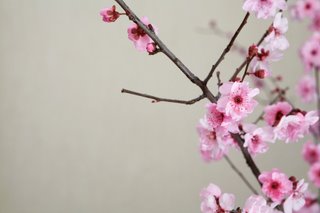 Cherry blossoms Researchers recently found that minutes-long meditation increases blood flow to the region of the brain that’s linked to learning and memory. In the morning, meditate for ten to 12 minutes before your cup of coffee or tea. (Caffeine can slow blood circulation to the brain.) Sit comfortably, let your eyes close and focus on your breath. If your thoughts start to wander, bring your attention back to your breath.
adpated from Natural Healing Magazine, November 2008
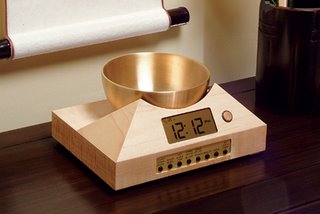 Zen Timepiece, a brass singing bowl clock and timer Now & Zen’s – The Zen Clock & Meditation Timer Sore
1638 Pearl Street
Boulder, CO 80302
(800) 779-6383
Posted in Bamboo Chime Clocks, Chime Alarm Clocks, intention, Meditation Timers, Meditation Tools, Now & Zen Alarm Clocks, Well-being, Yoga Timer, Yoga Timers by Now & Zen
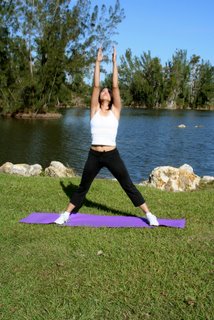 Yoga Moutain Pose Grounding, Balance
Finding balance in the midst of challenge is exactly what we try to achieve in our daily lives — and the practice of yoga is one that seeks to help us do it. One of the first things people notice when they bring their yoga practice outside, says Van Otten, is that unlike the flat surfaces we’re used to, the earth’s naturally uneven terrain presents its own challenge. You have to become more tuned in to where you’re putting your feet, with an eye out for rocks, tree roots, divots, and inclines. This constant conversation between mind and body keeps you mentally as well as physically engaged.
Earth Exercise
1. Begin in Mountain pose, bringing hands into prayer position.
2. Visualize breathing in the energy around you and breathing out love. The idea is not just to discard tension and anxiety but also to build reciprocal energy between you and your surroundings.
3. Reach your arms as high as you can, with heels planted and feet flat. Next, try reaching higher on the right side, then the left, three times on each side.
4. Round down into a forward fold. Hold this pose for five breaths with soft knees, hands flat on the ground.
5. Bend your legs a little, lowering your pelvis. Exhale as the knees bend; inhale and straighten. Do this three times.
6. Roll up slowly.
7. Stretch arms wide, then clasp your hands behind your back. Separate your feet to shoulder-width.
With a gentle backward bend, look up at the sky, drawing in solar, lunar, and stellar energy. Hold this pose for several breaths, then slowly return to Mountain pose.
To Experience the Earth
Practice barefoot. Do yoga on the grass; sense its coolness against your feet and palms. Imagine that the centers of your feet are over an energy spout — draw the energy up from the earth’s core, then let it flow out through the top of your head.
adapted from Wholeliving Magazine, July/August 2005 by Terri Trespicio
Use our unique “Zen Clock” which functions as a Yoga Timer. It features a long-resonating acoustic chime that brings your meditation or yoga session to a gradual close, preserving the environment of stillness while also acting as an effective time signal. Our Yoga Timer & Clock can be programmed to chime at the end of the meditation or yoga session or periodically throughout the session as a kind of sonic yantra. The beauty and functionality of the Zen Clock/Timer makes it a meditation tool that can actually help you “make time” for meditation in your life. Bring yourself back to balance.
 Digital Yoga Timer in Solid Walnut Now & Zen – The Yoga Timer Store
1638 Pearl Street
Boulder, CO 80302
(800) 779-6383
Posted in yoga, Yoga Timer, Yoga Timers by Now & Zen
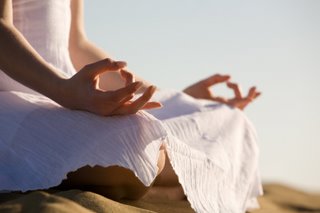 meditation reduces stress Dhyana heyah tad vrttayah.
Meditation removes disturbances of the mind. (Yoga Sutra II.11)
Research also shows that meditation can help people with anxiety disorders. Philippe Goldin, director of the Clinically Applied Affective Neuroscience project in the Department of Psychology at Stanford University, uses mindfulness meditation in his studies. The general practice is to become aware of the present moment—by paying attention to sounds, your breath, sensations in your body, or thoughts or feelings—and to observe without judgment and without trying to change what you notice.
Like most of us, the participants in Goldin’s studies suffer from all sorts of disturbances of the mind—worries, self-doubt, stress, and even panic. But people with anxiety disorders feel unable to escape from such thoughts and emotions, and find their lives overtaken by them. Goldin’s research shows that mindfulness meditation offers freedom for people with anxiety, in part by changing the way the brain responds to negative thoughts.
In his studies, participants take an eight-week mindfulness-based course in stress reduction. They meet once weekly for a class and practice on their own for up to an hour a day. The training includes mindfulness meditation, walking meditation, gentle yoga, and relaxation with body awareness as well as discussions about mindfulness in everyday life.
Before and after the intervention, participants have their brains scanned inside an fMRI (or functional MRI) machine, which looks at brain activity rather than the structure of the brain, while completing what Goldin calls “self-referential processing”—that is, thinking about themselves. An fMRI scanner tracks which brain areas consume more energy during meditation and, therefore, which regions are more active.
Ironically, the brain-scanning sessions could provoke anxiety even in the calmest of people. Participants must lie immobilized on their back with their head held in the brain scanner. They rest their teeth on dental wax to prevent any head movement or talking. They are then asked to reflect on different statements about themselves that appear on a screen in front of their face. Some of the statements are positive, but many of them are not, such as “I’m not OK the way I am,” or “Something’s wrong with me.” These are exactly the kinds of thoughts that plague people with anxiety.
The brain scans in Goldin’s studies show a surprising pattern. After the mindfulness intervention, participants have greater activity in a brain network associated with processing information when they reflect on negative self-statements. In other words, they pay more attention to the negative statements than they did before the intervention. And yet, they also show decreased activation in the amygdala—a region associated with stress and anxiety. Most important, the participants suffered less. “They reported less anxiety and worrying,” Goldin says. “They put themselves down less, and their self-esteem improved.”
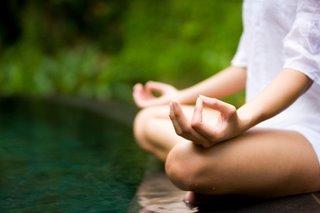 reduce stress with meditation Goldin’s interpretation of the findings is that mindfulness meditation teaches people with anxiety how to handle distressing thoughts and emotions without being overpowered by them. Most people either push away unpleasant thoughts or obsess over them—both of which give anxiety more power. “The goal of meditation is not to get rid of thoughts or emotions. The goal is to become more aware of your thoughts and emotions and learn how to move through them without getting stuck.” The brain scans suggest that the anxiety sufferers were learning to witness negative thoughts without going into a full-blown anxiety response. Research from other laboratories is confirming that mindfulness meditation can lead to lasting positive changes in the brain. For example, a recent study by Massachusetts General -Hospital and Harvard University put 26 highly stressed adults through an eight-week mindfulness-based course in stress reduction that followed the same basic format as Goldin’s study. Brain scans were taken before and after the intervention, along with participants’ own reports of stress. The participants who reported decreased stress also showed decreases in gray -matter density in the amygdala. Previous research had revealed that trauma and chronic stress can enlarge the amygdala and make it more reactive and more connected to other areas of the brain, leading to greater stress and anxiety. This study is one of the first documented cases showing change ocurring in the opposite direction—with the brain instead becoming less reactive and more resilient.
Together, these studies provide exciting evidence that small doses of mental training, such as an eight-week mindfulness course, can create important changes in one’s mental well-being.
adapted from Yoga Journal, by Kelly McGonigal
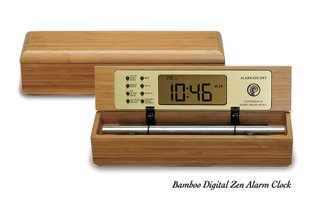 Bamboo Digital Zen Alarm Clock by Now & Zen Now & Zen’s Meditation Timer Store
1638 Pearl Street
Boulder, CO 80302
(800) 779-6383
Posted in Bamboo Chime Clocks, intention, Meditation Timers, Meditation Tools, mindfulness practice, Now & Zen Alarm Clocks, Well-being, Zen Timers
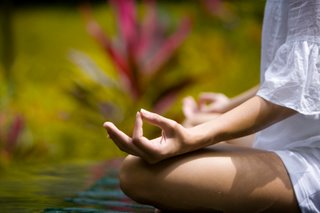 outdoor yoga routine Sometimes it’s hard to see that yoga is far more than a physical activity confined by time, space, and a mat. Too often we rush to class to secure a spot on the studio floor and begin our practice without taking note of our surroundings. We may compare our poses with those of others; we can get distracted by people wandering in and out of class or maneuvering for elbow room.
By getting out of the studio and into nature, you can experience yoga as it was originally intended. “Being outdoors gives you access to a whole other world of sensations. It helps you feel part of a boundless existence, at one with an intelligent and sympathetic universe,” says Garrett Sarley Dinabandhu, president of the Kripalu Center for Yoga and Health in Massachusetts’s Berkshire Mountains. The pure unpredictability of being outside and exposed to the elements can strengthen an existing practice or inspire a new one, Dinabandhu says.
Working with Michelle Van Otten, owner of Ultimate Outdoor Fitness in Los Gatos, California, and E. Barrie Kavasch, an expert in Native American wisdom and author of “The Medicine Wheel Garden,” we’ve developed a unique yoga-based routine that’s meant to be an out-of-studio experience.
This Four Elements Ritual — Earth, Wind, Fire, and Water — is designed to awaken your senses, enhance your focus, and help you reconnect to the natural world.
Tips for Outdoor Practice
To refresh your experience when you go outside, keep these four points in mind.
Find Your Place of Peace and Power
Everybody has access to some spot of natural power. It doesn’t have to be the Grand Canyon; it can be Central Park, a river, a stream, a hillside. Maybe it’s a place made special by its juxtaposition to what’s around it — an old oak tree next to a housing development or a water fountain in the middle of a city. If you open yourself to it, you can find lots of what Dinabandhu calls “little doorways into the natural rhythms of nature.”
Be Present
To most people, the outdoors is a transitional place — something they rush through on their way from one indoor environment to another; they’re not fully conscious of the world itself. The rewards of being present in nature are very fulfilling — but it’s an awareness you have to cultivate.
Start with Your Breath
Do a few ujjayi breaths to relax and slow down. Breathe slowly through your nose, allowing your belly to expand; slightly contract the back of the throat as you inhale and exhale to create the audible sound of an ujjayi breath, like ocean waves rushing over pebbles. Listen for the gentle rhythms of nature and allow your breath to fall in sync with it. With each breath, reach your sensory awareness toward your inner self and out into the world around you.
Go Slow and Slower
When you practice yoga outside, it’s not about how many asanas you do, but the quality of movement that enriches your practice. Think of moving from the inside out, following your body’s natural inclination and rhythms. Feel the currents of the air across your body and let that direct you. Enjoy the flow of one pose into another. Take your time.
adapted from Whole Living Magazine, July/August 2005 by Terri Trespicio
Use our unique “Zen Clock” which functions as a Yoga Timer. It features a long-resonating acoustic chime that brings your meditation or yoga session to a gradual close, preserving the environment of stillness while also acting as an effective time signal. Our Yoga Timer & Clock can be programmed to chime at the end of the meditation or yoga session or periodically throughout the session as a kind of sonic yantra. The beauty and functionality of the Zen Clock/Timer makes it a meditation tool that can actually help you “make time” for meditation in your life. Bring yourself back to balance.
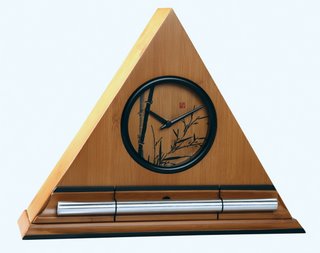 Bamboo Zen Alarm Clock with Chime, yoga timers from Boulder, CO Now & Zen – The Yoga Timer Store
1638 Pearl Street
Boulder, CO 80302
(800) 779-6383
Posted in Chime Alarm Clocks, Japanese Inspired Zen Clocks, Well-being, yoga, Yoga Timer, Yoga Timers by Now & Zen
 Yellow Flowers. c. 1900, unknown Exhaustion Cause: Disconnection from Nature
It’s hard to feel tired or anxious while hiking in the wilderness or staring out at a blue expanse of ocean. “Nature has built-in mechanisms for relieving stress,” says Doreen Sweeting, M.D., founder of Psychosomatic Wellness Intuitive Life Coaching. “There’s aromatherapy in the scent of the pine trees and grass, chromatherapy in the colors of the rocks and sky and flowers, sound therapy in the birdsong and wind rustling the leaves.”
Our society, unfortunately, is increasingly cut off from this wellspring of energy. “We live in artificial light. We walk on concrete. We exercise on machines,” Sweeting says. “We go from home to work to the store and back home.”
Exhaustion Cure: Take a Morning Walk
Set your Zen Timepiece to remind you whether you live in a suburb or a bustling city, to take a walk first thing in the morning — if possible, in an area filled with trees. “You’ll feel the energy of nature replenishing you,” says Sweeting. “The tree huggers are on to something.” As often as possible, venture deeper into the woods by planning day hikes or overnight camping trips.
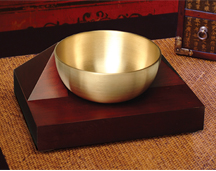 Signing Bowl Timers & Alarm Clocks Make an extra effort to notice the changing seasons. “You’ll start to realize the rhythms of nature apply to you, too,” Sweeting concludes. “When you harmonize yourself with nature, you’ll develop a stronger sense of well-being. The body responds quickly to being honored in this way. And it can all start with getting out to the park.”
adapted from Body+ Soul Magazine, September 2009
 Zen Chime Alarm Clock, Digital Black Lacquer Chime Clock Now & Zen’s Singing Bowl Clocks & Timers
1638 Pearl Street
Boulder, CO 80302
(800) 779-6383
Posted in Bamboo Chime Clocks
 yoga supported fish pose Beat the Blues
You can see next week’s deadlines and responsibilities building up like a wave about to crest.
Take a few moments of silence to coil your energy before you dive into another week. This pose helps ward off the Monday-morning blues, inviting energy into your body and mind.
Supported Fish
What It Does
Stretches the shoulders, neck, and chest; improves posture and deepens breathing, countering a forward hunch. Opens the heart and the throat chakras, bolstering courage and encouraging authentic expression.
How to Do It
Set your Zen Yoga Timer in Bamboo to chime after 5 minutes. Roll up a thin blanket and lie on your back, resting your shoulder blades on the blanket. If your head doesn’t comfortably reach the floor, place another blanket or small pillow underneath.
Let your breath rise and fall naturally, and stay here for 5 minutes, or as long as you like.
adatped from Body + Soul, 2010
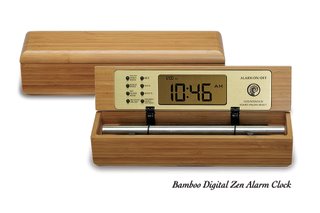 Bamboo Digital Chime Clock, a calming timer and alarm clock made from natural materials like bamboo, walnut, and maple Now & Zen’s Yoga Timer Store
1638 Pearl Street
Boulder, CO 80302
(800) 779-6383
Posted in Bamboo Chime Clocks, Japanese Inspired Zen Clocks, Meditation Timers, Meditation Tools, Now & Zen Alarm Clocks, Yoga Timer, Yoga Timers by Now & Zen
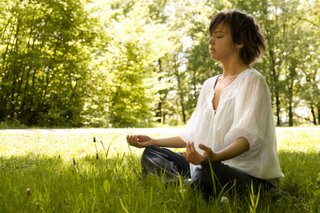 lovingkindness meditation Put it into practice.
Sit comfortably in a place where you won’t be disturbed. Take three to five quiet breaths. Gently close your eyes.
Imagine the horizon spanning through your chest with a radiant sun rising in your innermost center—your heart. As though being melted by the solar warmth, release tension in your shoulders and across your throat. Soften your forehead and rest your attention inward on the light deep within. Take 7 to 10 smooth, even breaths.
As you inhale, invite the glow from your heart to expand toward the inner surface of the body. With each exhale, let the light recede. Take another 7 to 10 peaceful breaths. Inhaling, invite the light to touch the parts of you that interact with the world—your eyes and ears, the voice center in your throat, the palms
of your hands, the soles of your feet. Exhaling, feel your light shine more clearly. As you continue to inhale and exhale, silently say: “I radiate friendliness for those who are happy, com-passion for those who are unhappy, equanimity toward all.” Continue until your attention wavers. Then, sit quietly for several minutes.
When you feel complete, place your palms together in front of your heart and bow your head. Release the backs of your hands to your thighs and lift your head. Gently open your eyes to return to the horizon of the world.
adapted from Yoga Journal, byKelly McGonigal
Use our unique “Zen Clock” which functions as a Yoga Timer. It features a long-resonating acoustic chime that brings your meditation or yoga session to a gradual close, preserving the environment of stillness while also acting as an effective time signal. Our Yoga Timer & Clock can be programmed to chime at the end of the meditation or yoga session or periodically throughout the session as a kind of sonic yantra. The beauty and functionality of the Zen Clock/Timer makes it a meditation tool that can actually help you “make time” for meditation in your life. Bring yourself back to balance.
 bamboo meditation timer Now & Zen – The Portable Meditation Timer Store
1638 Pearl Street
Boulder, CO 80302
(800) 779-6383
Posted in Bamboo Chime Clocks, intention, Meditation Timers, Meditation Tools, mindfulness practice, Now & Zen Alarm Clocks, Well-being, Zen Timepiece by Now & Zen, Zen Timers
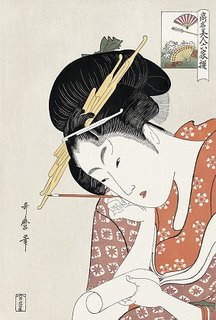 Utamaro Kitagawa, The Courtesan Hanaogi of Ogiya, Ukiyo-e Woodblock Print As far back as 300 B.C., the philosopher Chuang Tzu observed that when an archer was practicing, he shot with calming relaxation and skill. When a moderate financial award was placed in front of the archer, he got a little tense, his aim faltered and he often missed the target. When a large award was offered for his accuracy, he became nervous and worried, with obvious results. This led Chuang Tzu to wryly observe that, “He who looks too hard on the outside gets clumsy on the inside.”
In modern times people who play golf find their swing is near perfect when there is no ball to hit. But once a ball is placed on the tee and someone is keeping score, the inexperienced golfer’s swing inevitably fails and the ball goes off its intended path. When a golfer has a drink, he often becomes more relaxed and his game improves. So even though a specific feat can be improved by artificial means, it is at the expense of our being fully present and reduces our ability to respond to other circumstances. Imagine how our performance in everyday life would improve if we could learn to find rest and calming relaxation from within ourselves.
The question is, “How could we relax in the process of living?” or, “How can we have rest in our daily lives? How do we live for the rest of our lives?”
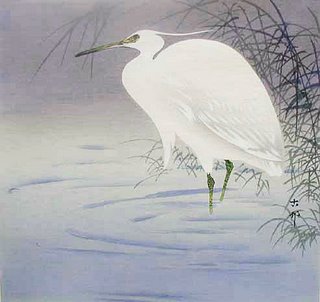 Ohara Koson (Shoson) 1877-1945, Ukiyo-e Here are six resting points or techniques that can assist us in finding rest and calming relaxation, peace, tranquility, and restoration within ourselves and within the great self that embraces and holds us all. Try one and you’re on your way to the rest of your life.
1. The Breath: Following the rise and fall of your breath can bring you to a peaceful and calm place and restore your energy. It brings you present. Allow your breath all the way into your belly to reduce stress. The key to natural and full breathing is in the exhalation – the letting go. However, don’t force anything.
2. The Nap: It is very underutilized in our culture. Twenty minutes is ideal but even a five-minute nap can be very restorative. Don’t go more than 20 minutes or you may feel groggy. If you only have a minute, try this. Hold some keys in your hands and bend forward in your chair with your lower arms resting on your thighs. As you nod off, the keys will drop and wake you up. Even in that minute, you will feel a little more refreshed. The point here is that taking a little time for yourself for rest, prayer, meditation, or spiritual exercises can profoundly affect the quality of your day. Remember to set your Zen Chime Timer to awaken you gently.
3. The Pause: Learning to pause is a great tool to have up your sleeve. Its value is in bringing you consciously present. You can pause a moment in your daily routine and say, “I am present. I am here, now.” Then allow yourself to be with whatever is revealed. A further refinement is to bring your attention to the pause between exhaling and inhaling. Even doing this once will give you a moment of rest and restoration.
4. Silence: The word “listen” contains the same letters as the word “silent.” Choose to be present and alert and to listen past the inner conversations of the mind. Listen past the sounds of the world and just listen to the silence. Listen attentively to whatever comes forward out of the silence. If things start to distract and disrupt you, bring your focus back to the silence. When you practice bringing your presence into the silence, you will experience a knowing and a wisdom that will start flowing within you. It will usually bring you to a state of peace, calm and clarity.
5. Doing nothing: A great way to interrupt the pattern of habitual doing. It is akin to entering a state of observation, where you perceive things clearly just for what they are. An analogy is watching boats going out to sea. You observe them as they pass you. Then you observe the next one. If you gawk or think about how you would like to be in a boat, you have moved out of observation. Observation is only about what is, not what you know or don’t know about a situation. The power that comes from that, internally, is tremendous. It’s an active place of neutrality. The process of observing what is, is the process that releases and restores us.
6. Meditation – Resting in Yourself: “To the mind that is still, the whole universe surrenders.” Lao-Tzu. When you haven’t developed an intimate relationship with life or with yourself, you’ll tend to look toward having sex or acquiring more money, or to any attractive distraction to fill the emptiness inside. To fill yourself, you have to be prepared to spend time alone – quality time with yourself, not with a good book, not watching television, art or with music. Although those have their place, learn to be quiet with your own inner self. Any time you can bring your focus onto one thing, a flower, a sacred word, a scene in nature, you are meditating. The simplest way to meditate is to observe the rising and falling of your breath.
 Zen Alarm Clock, Ukiyo-e Hokusai Wave Dial Face, mediation timer and clock Adapted from Men’s Health, June 2003 by Paul Kaye, DSS, President of the Movement of Spiritual Inner Awareness (MSIA)
Now & Zen’s – The Zen Alarm Clock Store
Meditation Time Shop
1638 Pearl Street
Boulder, CO 80302
Posted in Bamboo Chime Clocks, Chime Alarm Clocks, Japanese Inspired Zen Clocks, Meditation Timers, Meditation Tools, Natural Awakening, Now & Zen Alarm Clocks, prayer, Progressive Awakening, Well-being
« Previous Page
Next Entries »
|
|
|
|